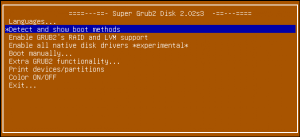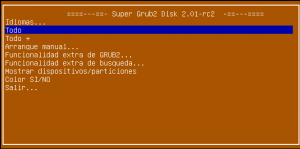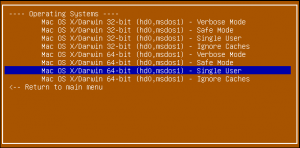Super Grub2 Disk 2.02s4 stable is here.
Super GRUB2 Disk is a live cd that helps you to boot into most any Operating System (OS) even if you cannot boot into it by normal means.
A new stable release
The former Super Grub2 Disk stable release was 2.00s3 version and released on May 2015 (10 months ago) . New features or changes since previous stable version are:
- Using upstream grub-2.02-beta3 tag as the new base for Super Grub2 Disk’s grub.
If Super Grub2 Disk 2.02s3 let you boot into your OS but Super Grub2 Disk 2.02s4 does not let you boot into your OS please report it so that we can report it back to the grub team which tries to release a Grub 2.02 stable release. - Major improvement in Windows OS detection (based on BCD) Windows Vista, 7, …
That means that even if Windows 7 is alone in the hard disk (with no GNU/Linux) it will now be detected and you will be able to boot it if the partition boot record is ok. The fix was trivial, take into account that ntfs is case sensitive but, somehow, not enough people had complained about it. So, please, if something it’s not working as expected report it. - Major improvement in Windows OS detection (based on ntldr) Windows XP, 2000, …
Same explanation as per Windows 7 but applied to Windows XP.

We are going to see which are the complete Super Grub2 Disk features with a demo video, where you can download it, the thank you – hall of fame and some thoughts about the Super Grub2 Disk development.
Please do not forget to read our howtos so that you can have step by step guides (how to make a cdrom or an usb, how to boot from it, etc) on how to use Super Grub2 Disk and, if needed, Rescatux.

Tour
Here there is a little video tour in order to discover most of Super Grub2 Disk options. The rest of the options you will have to discover them by yourself.
Features
Most of the features here will let you boot into your Operating Systems. The rest of the options will improve the Super Grub2 Disk operating systems autodetecting (enable RAID, LVM, etc.) or will deal with minor aspects of the user interface (Colours, language, etc.).
- Change the language UI
- Translated into several languages
- Spanish / Español
- German / Deutsch
- French / Français
- Italian / Italiano
- Malay / Bahasa Melayu

- Detect and show boot methods option to detect most Operating Systems

- Enable all native disk drivers *experimental* to detect most Operating Systems also in special devices or filesystems
- Boot manually
- Operating Systems
- grub.cfg – Extract entries

Super Grub2 Disk 2.01 beta 3 grub.cfg Extract entries option - grub.cfg – (GRUB2 configuration files)
- menu.lst – (GRUB legacy configuration files)
- core.img – (GRUB2 installation (even if mbr is overwritten))
- Disks and Partitions (Chainload)
- Bootable ISOs (in /boot-isos or /boot/boot-isos
- Extra GRUB2 functionality
- Enable GRUB2’s LVM support
- Enable GRUB2’s RAID support
- Enable GRUB2’s PATA support (to work around BIOS bugs/limitation)
- Mount encrypted volumes (LUKS and geli)
- Enable serial terminal
- Extra Search functionality
- Search in floppy ON/OFF
- Search in CDROM ON/OFF
- List Devices / Partitions
- Color ON /OFF
- Exit
- Halt the computer
- Reboot the computer
Supported Operating Systems
Excluding too custom kernels from university students Super Grub2 Disk can autodetect and boot most every Operating System. Some examples are written here so that Google bots can see it and also to make more confident the final user who searchs his own special (according to him) Operating System.
- Windows
- Windows Vista/7/8/8.1
- Windows NT/2000/XP
- Windows 98/ME
- MS-DOS
- FreeDOS
- GNU/Linux
- Direct Kernel with autodetected initrd

Super Grub2 Disk – Detect any Operating System – Linux kernels detected - vmlinuz-*
- linux-*
- kernel-genkernel-*
- Debian / Ubuntu / Mint
- Mageia
- Fedora / CentOS / Red Hat Enterprise Linux (RHEL)
- openSUSE / SuSE Linux Enterpsise Server (SLES)
- Arch
- Any many, many, more.
- Direct Kernel with autodetected initrd
- FreeBSD
- FreeBSD (single)
- FreeBSD (verbose)
- FreeBSD (no ACPI)
- FreeBSD (safe mode)
- FreeBSD (Default boot loader)
- EFI files
- Mac OS X/Darwin 32bit or 64bit

Support for different hardware platforms
Before this release we only had the hybrid version aimed at regular pcs. Now with the upcoming new EFI based machines you have the EFI standalone versions among others. What we don’t support is booting when secure boot is enabled.
- Most any PC thanks to hybrid version (i386, x86_64, x86_64-efi) (ISO)
- EFI x86_64 standalone version (EFI)
- Additional Floppy, CD and USB in one download (ISO)
- i386-pc
- x86_64-efi
Known bugs
- Non English translations are not completed
- Enable all native disk drivers *experimental* crashes Virtualbox randomly
Supported Media
- Compact Disk – Read Only Memory (CD-ROM) / DVD
- Universal Serial Bus (USB) devices
- Floppy (1.98s1 version only)
Downloads
Recommended download (Floppy, CD & USB in one) (Valid for i386, x86_64, and x86_64-efi):

EFI x86_64 standalone version:
CD & USB in one downloads:
- Super Grub2 Disk (Floppy, CD & USB in one) 2.02s4 [i386-pc] (ISO)[Mirror #1]
- Super Grub2 Disk (Floppy, CD & USB in one) 2.02s4 [x86_64-efi] (ISO)[Mirror #1]
About other downloads. As this is the first time I develop Super Grub2 Disk out of source code (well, probably not the first time, but the first time in ages) I have not been able to build these other downloads: coreboot, i386-efi, i386-pc, ieee1275, x86_64-efi, standalone coreboot, standalone i386-efi, standalone ieee1275. Help is welcome on this subject.
Source code:
Everything (All binary releases and source code):
Hashes
In order to check the former downloads you can either check the download directory page for this release
or you can check checksums right here:
MD5SUMS
dcb779162fad41805839f709897f8c9e super_grub2_disk_hybrid_2.02s4.iso aa5c41e32554f9e5150f70e0fa621d80 super_grub2_disk_i386_pc_2.02s4.iso 48c7a8464543d783936cf92656bf4b5f super_grub2_disk_standalone_x86_64_efi_2.02s4.EFI 91e81de1e92d3364026823a722d050b7 super_grub2_disk_x86_64_efi_2.02s4.iso
SHA1SUMS
6fed370c439d298d64aa99bf10d0ffc8d078de5e super_grub2_disk_hybrid_2.02s4.iso cde22454c213d050c96643e4d93d45f7592bc2d5 super_grub2_disk_i386_pc_2.02s4.iso 41e5de11fea74ce2ba7a543be3a00ecb6d8f2333 super_grub2_disk_standalone_x86_64_efi_2.02s4.EFI e3864e1a8b41021a38885f8bfba5dc57f0ec323d super_grub2_disk_x86_64_efi_2.02s4.iso
SHA256SUMS
a60bc71148e3f8f669ba2a131c4bc1352e0f34164f1f0ddae695462ad6f9ae7b super_grub2_disk_hybrid_2.02s4.iso d2fc6346885ef2aa96360f288b6fc3f3c8c2880c8f7e86bdf60d77a65958a6e9 super_grub2_disk_i386_pc_2.02s4.iso 009092adcd4af6eaca051873d87976684be8142ec5dfb6cccb843ad6e001fe5a super_grub2_disk_standalone_x86_64_efi_2.02s4.EFI d6cbddfd762db93ef03b374700bed061fd2a50a8d8523272cba8804b7833952d super_grub2_disk_x86_64_efi_2.02s4.iso
Changelog (since former 2.00s2 stable release)
Changes since 2.02s3 version:
- Using upstream grub-2.02-beta3 tag as the new base for Super Grub2 Disk’s grub.
- Major improvement in Windows OS detection (based on BCD) Windows Vista, 7, …
- Major improvement in Windows OS detection (based on ntldr) Windows XP, 2000, …
Changes since 2.02s2 beta 1 version:
- (Devel) grub-mkstandalone was deleted because we no longer use it
- Updated (and added) Copyright notices for 2015
- New option: ‘Disks and Partitions (Chainload)’ adapted from Smx work
- Many files were rewritten so that they only loop between devices that actually need to be searched into.
This enhacement will make Super Grub2 Disk faster. - Remove Super Grub2 Disk own devices from search by default. Added an option to be able to enable/disable the Super Grub2 Disk own devices search.
2.02s2 beta 1 changelog:
- Updated grub 2.02 build to commit: 8e5bc2f4d3767485e729ed96ea943570d1cb1e45
- Updated documentation for building Super Grub2 Disk
- Improvement on upstream grub (d29259b134257458a98c1ddc05d2a36c677ded37 – test: do not stop after first file test or closing bracket) will probably make Super Grub2 Disk run faster.
- Added new grub build scripts so that Super Grub2 Disk uses its own built versions of grub and not the default system / distro / chroot one.
- Ensure that Mac OS X entries are detected ok thanks to Users dir. This is because Grub2 needs to emulate Mac OS X kernel so that it’s detected as a proper boot device on Apple computers.
- Thanks to upstream grub improvement now Super Grub2 Disk supports booting in EFI mode when booted from a USB device / hard disk. Actually SG2D was announced previously to boot from EFI from a USB device while it only booted from a cdrom.
2.02s1 beta 1 changelog:
- Added new option: “Enable all native disk drivers” so that you can try to load: SATA, PATA and USB hard disks (and their partitions) as native disk drives. This is experimental.
- Removed no longer needed options: “Enable USB” and “Enable PATA”.
- “Search floppy” and “Search cdrom” options were moved into “Extra GRUB2 functionality menu”. At the same time “Extra Search functionality” menu was removed.
- Added new straight-forward option: “Enable GRUB2’s RAID and LVM support”.
- “List devices/partitions” was renamed to “Print devices/partitions”.
- “Everything” option was renamed to “Detect and show boot methods”.
- “Everything +” option was removed to avoid confusions.
- Other minor improvements in the source code.
- Updated translation files. Now most translations are pending.
- Updated INSTALL instructions.
Finally you can check all the detailed changes at our GIT commits.
If you want to translate into your language please check TRANSLATION file at source code to learn how to translate into your language.
Thank you – Hall of fame
I want to thank in alphabetical order:
- bfree (Niall Wash): For his work in rethinking how Super Grub2 Disk grub script might be rewritten although we never used that code. For adding code for EFI chainloader, helping on building and testing Super Grub2 Disk EFI releases.
- Jordan_U (Jordan Uggla) (jordan.uggla AT gmail DOT com): For his work in rewriting Lua Super Grub2 Disk into new Grub2 scripting. Also for his work in translation system based on gettext and po. And also I want to thank him for all this work in Super Grub2 Disk in many many ways.
- nox (Juergen Lock) (nox AT freebsd DOT org): For his work in fixing *BSD boot entries and helping adding new *BSD boot entries and testing.
- Smx (Stefano): For his Mac OS X / Darwin boot fixes and testing. He has also worked in redesigning some of the menues and probably his work will be included in next Super Grub2 Disk versions. He has also worked in a keyboard selection menu on his own too. That will be also included in next versions.
The person who writes this article is adrian15 and is proud of being responsible among other things for the rewriting of options as if they were libraries. And also for the User Interface (UI) complete redesign.
And I cannot forget about thanking bTactic, the enterprise where I work at and that hosts our site.
Some thoughts about Super Grub2 Disk development
Super Grub2 Disk development ideas
I don’t know when but I plan to readapt some scripts from os-prober. That will let us detect more operating systems. Not sure when though. I mean, it’s not something that worries me because it does not affect too many final users. But, well, it’s something new that I hadn’t thought about.
Again, please send us feedback on what you think it’s missing on Super Grub2 Disk.
Rescatux development
I want to focus on Rescatux development on the next months so that we have an stable release before the end of 2016. It’s a shame because last time I predicted July 2015. But, well, I don’t want to maintain many forks myself. That’s why I want to contribute some of these subprojects (E.g. UEFI support on Debian Live) to Debian properly and that takes some time.
(adrian15 speaking)
Hello,
Thanks a lot for Super Grub Disk 2, it help me repair my multiboot system a lot of time without reinstalling everything.
I recently downloaded rescatux and installed it on my multisystem (thanks to YUMI) USB key (boot it if your PC doesn’t do anything) so i need to test it but it seems full of promises.
Thanks again for your work !
Sincerely,
Frank from France